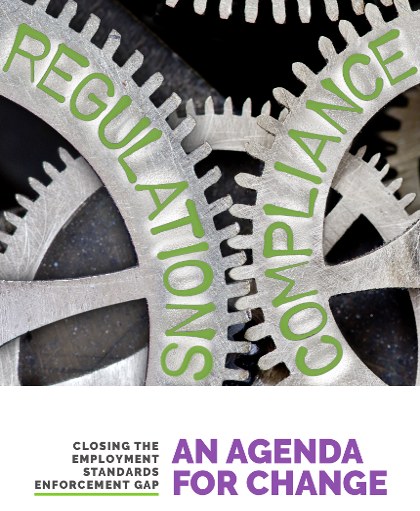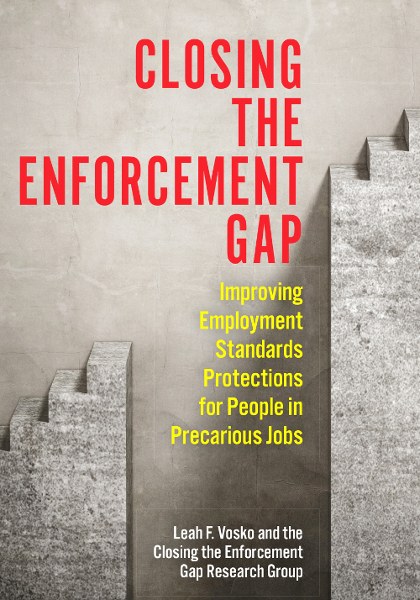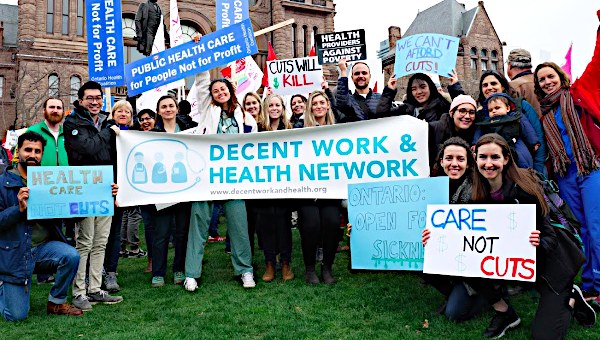Closing the Enforcement Gap: The Pandemic and Precarious Employment
As of March 15th, Ontario will have spent a full year in some form of lockdown. More than 22,000 Ontarians have died from COVID-19, hundreds of thousands of jobs have been lost, and the insufficiency of both the economic and public health responses have caused the burden of insecurity and illness to fall disproportionately on the backs of the most vulnerable people living in the province. Through this crisis, labour, precarity, and the future of work have been a salient topic – from the concept of ‘essential work’ to the Canada Emergency Response Benefit (CERB) and unemployment benefits.
To reflect back on this year, Bruce Kecskes and Amadeus Narbutt of the Scarlett Standard podcast interviewed Leah Vosko about the COVID-19 pandemic’s impact on employment standards, essential work, precarious employment, and migrant farm workers.
Leah F. Vosko is Professor of Political Science at York University and Canada Research Chair in the Political Economy of Gender and Work. The discussion explores topics found in her new co-authored book Closing the Enforcement Gap: Improving Employment Standards Protections for People in Precarious Jobs, a collaborative project, flowing from a community-university partnership.
Bruce Kecskes and Amadeus Narbutt (BK, AN): In Ontario, the Employment Standards Acts (ESA) is the principal source of workplace protection for a disquietingly large portion of workers. This is especially true among working Ontarians in precarious employment. However, as you put it in your new book, “For too many employees, employment standards are paper rights not realizable in practice.” What do you see as the primary sources of this enforcement gap of ESA standards? Has the changing landscape of precarious employment, and the advent of novel and non-standard employment relations, simply outpaced regulatory capabilities?
Leah F. Vosko (LV): When protective legislation, through Factories Acts, was extended to a larger group of people beyond women and children to address the need for minimum standards, there were tensions between wanting to provide a floor of labour protections, and business’s demands to remain free of interference. This tension still exists today. However, in recent years, we have seen the growing influence of regulatory new governance, which views the proper role of government as steering instead of rowing, and thus pursues arrangements that disperse regulatory activity among state actors, employers, and employees.
In the domain of employment standards regulation, the influence of this paradigm has led governments towards a compliance approach. A compliance approach views violations as flowing from employer ignorance or incompetence, resulting in an emphasis on providing compliance assistance rather than on deterring violations. This approach, in turn, results in a reactive complaints system, under-resourcing of proactive inspections, and lack of real deterrence measures (the ones that exist are not strong enough and they are rarely used). There is also an emphasis on efficient service delivery, where efficiency is interpreted quantitatively to mean ‘closing cases’ rather than looking qualitatively at the nature of outcomes of disputes.

Regarding your point about the changing landscape of precarious employment, that’s an interesting question. I would not necessarily argue that labour market restructuring is outpacing regulatory changes, but rather, that there is a growing disjunct between the nature of employment and the design and organization of labour laws and policies, which is correctable if there is the political will to do so.
In terms of the disjunct, forms of employment which differ from the standard employment relationship model (full-time permanent continuous employment with a single employer) have been on the rise in Ontario. For instance, the number of employees working part-time, a form of employment particularly common among women, increased considerably between 1976 and 1993 and stabilized at high levels thereafter. Additionally, as many employers pursued flexibility-enhancing labour strategies in an attempt to reduce their labour costs, especially those associated with termination or severance pay, the share of non-permanent employment, including contract/term, seasonal, casual, agency, and on-call employment, more than doubled, from 5 per cent in 1989 to 13 per cent in 2018. Between 1997 and 2018, there was also a steady increase in the share of temporary employees, especially in the public sector.
Industry is a valuable entry point into understanding the dynamics of labour market insecurity. It is especially so given the importance of context in shaping whether, and to what degree, a job is precarious. For example, larger economic trends such as industrial restructuring interact with the changing nature and organization of firms, such as the growing tendency of lead businesses to avoid having employees through contracting out and related processes.
In Ontario, the accommodation and food services industry has the greatest prevalence of employees in precarious jobs – fully 74 per cent in 2018. Unionization rates are extremely low in this industry; 93 per cent of employees are non-unionized, and an overwhelming majority of employees in this industry also earn low wages – full 75 per cent. These trends are notable, given the relatively high proportion of immigrant women employed in this sector. Even though only 3.7 per cent of Ontario employees are recent immigrant women, 6.1 per cent of employees in the accommodation and food services industry are recent immigrant women. The retail industry, a highly feminized domain, also has a high prevalence of precarious employment. Fifty-five per cent of employees in the retail sector hold precarious jobs. The retail industry also has extremely low union density and a high prevalence of low-wage employment.
The agricultural industry has a similarly high concentration of precarious employment; fully 55 per cent of employees in this industry are precariously employed, and 98 per cent of agricultural employees do not belong to a union. Agricultural workers are also subject to a range of exemptions and special rules under the ESA that further attenuate their (in) access to its social minimum. The reduced level of protection experienced by many agricultural employees is exacerbated by structural inequalities related to race as it interacts with migration status. A sizable portion of agricultural employees in Ontario comprises racialized workers from Mexico and the Caribbean, as well as increasingly other countries in Latin America, such as Guatemala, holding temporary work permits that limit them to employment in temporary migrant work programs exclusively, programs that provide almost exclusively for employer-tied work permits. Almost half (45 per cent) of employees in the management/administrative/business support industry, which includes forms of work such as office administration, security, and building services, are also precariously employed. Low union density and high rates of low-wage work characterize this industry. In addition, both the accommodations and food services industry, and the management, administration, and other support service industry have higher levels of temporary employment – another indication of uncertainty – than non-unionized employees in the province overall.
Notably, these industries are also characterized by extensive fissuring. A term brought into widespread use by Dr. David Weil, fissuring refers to processes through which lead businesses avoid hiring their own employees by making greater use of subcontracting, franchising, supply chains, temporary help agencies, and other such mechanisms. Its growing prevalence contributes to precarious employment in many industries in Ontario. Through fissuring, lead businesses transfer responsibility for the employees to smaller intermediary firms. These smaller intermediaries operate in highly competitive environments and are under pressure to reduce labour costs. At the lower end of the labour market, in expanding economic sectors such as accommodations and food services, agriculture, and retail and administrative services, the increasing prevalence of fissured workplaces makes employment standards violations a key strategy of labour cost containment. Ontario’s employment standards regime is not well equipped to extend legal obligations associated with employment standards beyond the immediate employer (narrowly conceived) to lead firms that create and benefit from fissured arrangements.
BK, AN: You have written about the highly gendered and racialized composition of many of the industries that are most associated with precarious employment in Ontario. Can you elaborate further on who is most likely to be employed precariously, and what factors shape workers’ experience of precariousness?
LV: In terms of social location, young people aged fifteen to twenty-four are far more likely to be precariously employed than older workers. This disparity is attributable in part to young people’s tendency to hold part-time and temporary forms of employment. Compared to their older counterparts, young people are more likely to hold non-unionized positions, work in small firms, earn low wages, and have short job tenure. In addition, young people are more likely to report working multiple jobs. Cumulatively, 70 per cent of young employees are in precarious jobs, compared to 19 per cent of employees aged twenty-five to fifty-four, or 21 per cent of those fifty-five years or older.
Gender also shapes Ontario employees’ experience of precariousness. Most notably, women are much more likely than men to earn low wages: in 2018, almost a third of women (31 per cent) earned low wages, compared to only 23 per cent of men. Overall, cumulatively, women are also considerably more likely to hold precarious jobs; in 2018, nearly 30 per cent of women compared to approximately 24 per cent of men were in this situation.
Recent immigrants to Canada (those who arrived 10 years ago or less) also experience high rates of precarious employment in Ontario. They are more likely to be employed in jobs that are non-unionized, that are low waged, and that are in small firms, and they are more likely to have a job tenure of less than one year than other employees. Using the cumulative measure of precarious employment, recent immigrants are much more likely to be precariously employed than other employees (37 per cent compared to 29 per cent, respectively). It is worth noting that among immigrants to Canada there are substantial variations in labour market outcomes shaped by migration period (i.e., period of arrival in Canada) and larger patterns of racialization in the labour force. In Canada, and likewise in Ontario, recent immigrants are much more likely to be racialized than those who arrived in the past. Prior to 1975, only about one in five immigrants were racialized; in comparison, in 2011, about four in five immigrants were racialized.
The growing proportion of racialized immigrants is notable, since racialized immigrants (and racialized employees more generally) tend to have lower earnings when they enter the labour force. Among recent immigrants in Ontario (i.e., those who arrived between 2006 and 2015), 54 per cent of racialized employees earned low annual wages in 2015, compared to 37 per cent of non-racialized employees. This trend is evident among immigrants who arrived between 1975 and 2006 as well. Regardless of their place of birth, racialized people tend to earn less, are more likely to live in low-income and/or in poverty, and to be unemployed than those that are non-racialized. Despite the importance of racialization in the experiences and outcomes of immigrants, information on race or “visible minority status” is not collected in Canada’s Labour Force Survey, inhibiting more detailed analyses of the intersections between dimensions of labour market insecurity, particularly between racialization and firm size, job tenure, and permanent/temporary job status.
The gendered nature of certain facets of precariousness is even more pronounced among recent immigrants than among other employees. For instance, recent immigrant women are more likely than recent immigrant men to be employed in small firms, whereas there is no such gender disparity among other employees. Fully 44 per cent of recent immigrant women earn low wages, compared to only 30 per cent of recent immigrant men. Overall, recent immigrant women are substantially more likely to be in precarious employment, compared to both recent immigrant men and other employed women.
BK, AN: If, theoretically, we could close the enforcement gap of the ESA, would that sufficiently protect Ontario’s most precariously employed, bringing them more in line with workers in the SER mold of employment? Enforcement gaps aside, where does the ESA fail in fulfilling its mandate?
LV: I assume that you are pointing to the limits in the scope of the ESA here.
If so, I would argue that certain changes in that regard in the legislation itself are important – including, for example, expanding the definition of who is an employee protected by the ESA. This could be done by embracing an ABC test (see next paragraph for explanation), and improving provisions for joint and several liability to ensure that all related employers/entities are responsible for ES protections. Specifically, without even changing the definition of employee, the province could create a legal presumption of employee status for workers performing or providing labour services for a fee. The effect of a legal presumption of employment status (under the Employment Standards Act) would be to shift the burden of proof of demonstrating that someone is an independent contractor and therefore not covered by the ESA onto the employer.
In order to overcome the presumption of employment, companies would have to demonstrate that workers do not meet what has come to be termed as the ABC test, which has been adopted in some 27 states south of the border. This test requires that employers demonstrate that: A) an individual is free from control or direction over performance of the work, both under contract and in fact. B) the service provided is outside the usual course of the business for which it is performed. C) an individual is customarily engaged in an independently established trade, occupation, or business. That said, there is still the danger that entities in the gig economy, like companies in the delivery business, would attempt to rewrite contracts to retain drivers as independent contractors as line drawing always remains a problem. Still, this option has a lot of promise where it has been adopted. Qualitative improvements are also merited, such as provision for paid sick and caregiver leave, whereby employers are first payers and, of course, this should be pursued as a complement to federal measures through the EI system, expanding its scope of coverage, as well as the duration and level of benefits to reflect the changing nature of employment.
BK, AN: COVID-19 has yielded unprecedented levels of unemployment across Canada. At its peak, COVID-related unemployment more than tripled the unemployment rate following the 2007-08 financial crisis. We know from the fallout of the 2008 financial crisis that high levels of unemployment translate to increasing levels of precarious employment as a total share of employment, as lost jobs characterized by security are replaced by more flexible arrangements. What do you view as the long-term impact of COVID-19 with respect to precarious employment in Ontario?
LV: Here, I’m worried about a number of issues, many of which can be rectified by closing preexisting enforcement gaps.
One thing I’m concerned about, like many others, is the rise of on-demand or gig work. I’m thinking here of not just the delivery companies of this world but of other on-demand gig platforms where, as a matter of course, workers (i.e., people compelled to work for remuneration) are not treated as such; that is, they are denied partial or full access to labour and social protection.
One way to deal with the problem is by introducing, as I mentioned previously, an expanded definition of who is an employee under the ESA so that its provisions also apply to these gig workers. Another is by way of supply chain regulation of the sort that addresses fissuring through the designation of all these entities, including so called clients, within a supply chain responsible for employment standards. Doing this would also help other workers (like many PSWs, for example) who are unfairly deemed entrepreneurs, since through these gig platforms they are technically independent contractors.
Another major concern I have is the rising ‘she-cession’, which is also deeply racialized – that is, affecting women of colour disproportionately.
Here I see solutions within the framework of the ESA, but also externally:
Inside the ESA, the arguments of organizations such as the Workers’ Action Centre and the Good Jobs Coalition, and campaigns such as $15 and Fairness have never been so important; we need a decent wage floor now more than ever. So too are the arguments for parity between part-time and temporary workers, and full-time and permanent workers in a range of areas, including thresholds for benefits.
Crucially, employment standards protections subject to exemptions or partial exemptions must be eliminated. There is a fundamental need to remove exemptions and special rules applicable in industries where workers belonging to historically marginalized equity-seeking groups also dominate. Here I’m thinking about workers in agriculture as well as personal service workers (PSWs); for these two groups, exemptions already place them below the minimum floor of protections. Agricultural workers are exempt from minimum wage, overtime, public holidays, and vacation time/pay to conform to the ‘flexibility’ of farm work. PSWs, on the other hand, are only entitled to the minimum for the first 12 hours of work and are exempt for hours of work provisions, including eating periods, daily rest, and overtime, all for the same ‘flexibility’ rationale.
Outside the ESA, never has there been a greater need for childcare that is high quality and accessible. Not only for young ones, but also aftercare for school-aged children so that parents can make ends meet. So, too, is the grave need for affordable housing more pressing than ever. In the face of the pandemic, racialized and gendered precariousness in employment shapes and is shaped by these manifestations of the gaping holes in our social safety net.
BK, AN: How did the idea of ‘essential workers’ become mainstream after COVID began to impact the economy? Did it create openings for a broader discussion about the response of the Canadian state?
LV: Generally, I would say yes. It has definitely opened discussion around what we owe workers, to use a turn of phrase Eric Tucker, Sarah Marsden and I adopt in some recent work on sick and caregiver leaves, in terms of minimum wage, paid sick and caregiver leaves, etc. Workers in retail, food services, agriculture, warehousing, etc. are essential yet are apparently not worth enough to secure living wages and sick time.
Considering particular groups, migrant agricultural workers are a key example. We’ve seen severe outbreaks among this group, and this has brought the sorry state of housing (characterized by overcrowding and poor ventilation), a lack of healthcare, and inadequate income support overall (despite the CERB) into clear view, not to mention confinement on farms, and also – and this is key to meaningful employment standards and occupational health and safety protections – the veritable fear of reprisal that makes workers’ hesitant to complain about, for example, lack of access to those Employment Standards that apply and Occupational Health and Safety rights, such as proper personal protective equipment, often at the cost of their health and safety.
We must ask ourselves: at what and whose price are we prioritizing cheap food?
Considering particular cross-cutting needs, another area that I’ve been working on is improvements to sick and caregiver leaves. The pandemic brought to the fore the centrality of social reproduction to the economy. It also showed that the daily supports and provisioning for people – that is, supports that enable workers to rest, recover, and enable themselves to engage in paid and unpaid work day after day – are not there. Therefore, when people get sick – including these essential workers – they go back to their jobs because they have no choice.
We already knew working while ill was a major problem in Ontario; the Decent Work and Health Care Network’s sick leave campaign was already underway well before the pandemic, for example.
However, the spread of COVID 19 has shown how these leaves are indispensable. In my view, and based on research findings to which I’ve contributed with Tucker and Marsden, we need leaves, pursued on the basis of substantive gender equality, that are founded on the following principles: universality, sufficiency, security, and worker-centred flexibility. While the recognition of illness, for some fifty-years in the case of Employment Insurance (EI), and the fairly recent recognition of caregiving beyond the parent–infant relationship is a welcome start, the COVID-19 crisis opens space for – and underscores the necessity of – making radical, rather than incremental, and indeed ad hoc, reforms. It presents an opportunity to construct a more inclusive regime, which reconceives what is “standard” to reflect the lived realities of workers, and which reverses the trend toward universal commodification in ways that are materially beneficial to all.
Under federal EI, sickness benefits, which I’ll focus on here and which are the second most significant in volume among special benefits, provide income replacement in the case of injury, illness, or quarantine. Some workers, however, are ineligible – specifically, self-employed workers who have not registered for special benefits or have been registered for fewer than twelve months.
Workers who are otherwise eligible may be excluded at the point of entry, by way of hours requirements in the case of employees, and earnings requirements in the case of registered self-employed workers in good standing (i.e., who have paid premiums for twelve months). To be eligible, workers who are employees must have accumulated six hundred hours of insurable employment in the fifty-two weeks preceding the claim, and those that are self-employed must meet an equivalent minimum earnings requirement (e.g., those qualified to claim benefits in 2020 had to earn a minimum of $7,279 in 2019). These entry requirements are most likely to disadvantage the most precariously employed workers who are disproportionately women, youth, recent immigrants, rural workers, and sales and service workers.
The existing EI regime also fails on the principle of sufficiency. Using the CERB as a precedent, a minimum of $500 pre-tax income per week, adjusted annually to the rate of inflation to keep pace with change, might be a starting point.
Furthermore, while federal EI sickness benefits provide partial short-term income replacement for a subset of workers (currently a maximum of 15 weeks, which the government has promised to extend) and a temporary Canada Recovery Sickness Benefit (CRSB) covers a maximum 4 weeks for COVID related illness/quarantines, they do not provide benefits for individual sick days or provide job-protected leave. Instead, provincial employment standards laws fulfill this role for most workers.
In Ontario, employees who have been employed for a minimum of two weeks are entitled to three unpaid sick days annually, with the right to return to their position and protection from dismissal. For some COVID-19 related absences, Ontario has also introduced temporary job security provisions in the form of ‘Infectious Disease Emergency Leave’ with no specified limit on duration.
There is, therefore, a substantial mismatch between EI sickness benefits and leave protections under the Employment Standard Act (ESA). Provincial employment standards laws should be amended to provide protections and job security for at least the length of time for which federal benefits are available.
Critically, Ontario employment standards are missing in action when it comes to ensuring all workers have individual paid sick days – for example, when someone has the flu or is awaiting COVID test results. Vulnerable and low-paid workers, including those hailed as essential workers, are the least likely to have employer-paid sick days. Community coalitions like the $15 and Fairness campaign advocate for a new employment standard that ensures all workers have a right to 7 paid sick days with an additional 14 paid sick days during public health emergencies.
BK, AN: This summer, 1300 migrant agricultural workers in Ontario contracted COVID-19, 3 of whom died. Considering what you learned in your other new book, Disrupting Deportability: Transnational Workers Organize, how did our COVID response specifically, and migrant farmworkers programs in Ontario more generally, respond to these workers who are so critical to our collective food security? What should we be doing now to address this, as spring and summer months approach?
LV: Migrant workers entering under the auspices of the Temporary Foreign Workers Program (TFWP) do not receive pay commensurate with their experience, expertise, or the hazards of their job. They have no occupational mobility and injured workers face barriers to receiving health care and compensation. On top of enduring prolonged separation from their own families and communities, these workers are constantly at risk of deportation or reprisal and face tremendous legal obstacles to unionization and collective bargaining.
Migrant farm workers enter Canada principally under two subprograms of the TFWP – the Seasonal Agricultural Workers’ Program and the Agricultural Stream. These programs support the agriculture industry’s – and the receiving state’s – interest in sustaining global competitiveness through structurally disempowered labour, as well as the sending state’s reliance on personal remittances.
Migrant farmworkers’ conditions of entry under the TFWP produce precarious migration statuses compromising workers’ security of presence, and thereby, their capacity to mobilize in their own interests, processes I document in Disrupting Deportability. Work permits are time-limited and employer-specific, and growers may terminate and effectively repatriate farmworkers whenever they see fit. Additionally, migrant farmworkers are excluded from general legislation governing collective bargaining in Canada’s most populous province (i.e., Ontario’s Labour Relations Act) and relegated to coverage under the inferior Agricultural Employees Protection Act. In recent years, Canada’s federal government has made efforts to introduce changes to the TFWP to limit exploitation of migrant workers. Yet, such efforts leave intact the legal inequalities curtailing these workers’ ability to demand more secure and just conditions.
Our COVID response has neglected these workers in specific ways as well. Workers on farms have been subject to strict restrictions on daily mobility, with their capacity to leave workplaces and employer-provided housing constrained on the false and xenophobic assumption that they are vectors of COVID-19. Defying federal governmental guidelines, much on-farm housing also routinely lacks proper ventilation and spacing for necessary distancing, and many migrant workers are devoid of personal protective equipment and safe transportation on-the-job, as well as access to services, such as healthcare, and information critical to their well-being. In the case of this situation, as you mention in your question, three farmworkers died preventable deaths in Ontario at the peak of the pandemic’s first wave, and many farms have had outbreaks since; indeed, bringing the figure you cite in your question up to date, as of February 2021, a total of 2,472 farmworkers have tested positive for the virus according to official counts.
Significant changes are required to address this situation now. The Migrant Worker Health Expert Working Group, of which I am a member, has recommended, among other detailed interventions, the following actions in regard to these concerns: extensive on-site labour inspection with the provision of a firewall between labour inspectors and the Canada Border Services Agency; a national standard on housing, safe transportation, equitable access to healthcare, income security for migrant farmworkers and their families; and accessible pathways to permanent residency.
BK, AN: What efforts exist to improve working conditions and fight for justice for migrant farm workers? How can Ontarians help these struggles?
LV: While I have been most centrally involved with the Migrant Worker Health Expert Working Group that formulated the recommendations above and continues to advocate on this issue during the pandemic, migrant justice groups, such as Justicia for Migrant Workers and Migrant Rights Network are calling for permanent residency on arrival, open work permits, fully accessible health care, EI, and other benefits, as well as comprehensive protection from employer reprisals and repatriation. I encourage Ontarians to support these grassroots advocacy groups and pressure their MPPs for change. •






